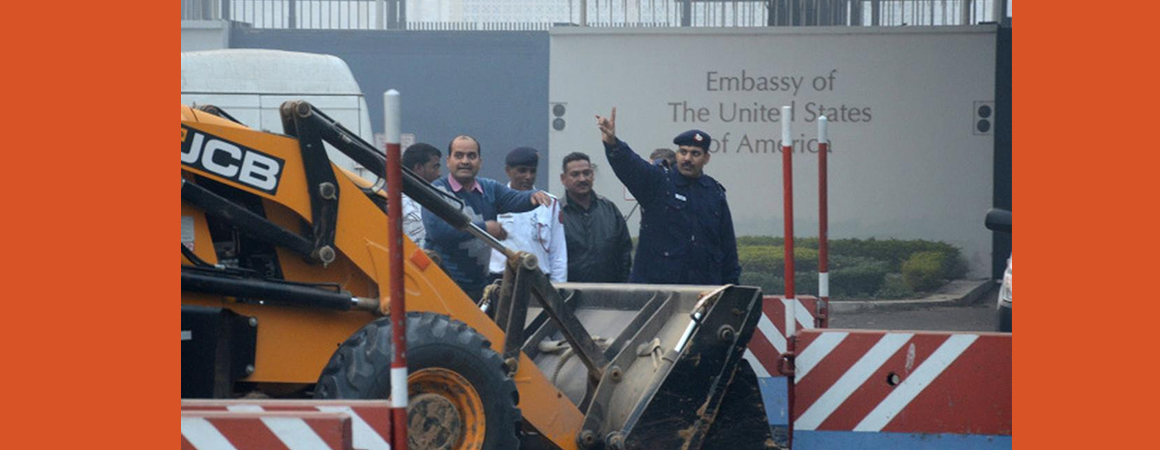In the new age of social media and diplomatic brinkmanship, it has become more difficult to keep things civil
“Empty chairs and empty tables….” Lines from the musical version of Victor Hugo’s Les Misérables came to my mind as I walked into the Pakistan High Commission on a winter’s day in the early 2000s. After the attack on the Indian Parliament, and the mobilisation of the Indian Army at the border in Operation Parakram, India and Pakistan had downsized their missions. As a result, several offices I walked through, as I sought a visa to cover developments in Pakistan, were completely bereft of occupants and the lone visa officer processing papers looked visibly harassed. In 2003, the acting high commissioner was accused of funding separatists in Kashmir and expelled, leading to a further downsizing of the Indian High Commission in Pakistan and the Pakistani High Commission in India. While tensions between the two countries were always high, people-to-people ties had somehow survived. However, two decades later, the situation is far worse. The downsizing of missions post-2019 seems more or less permanent, there are few exchanges of cultural and sporting visits, fewer visas for divided families, and no visas for journalists at all.
In the normal course, diplomats are unemotional and polite to a fault. Diplomatic “incidents” are handled behind closed doors. Mostly, even the sharpest demarches are delivered by foreign ministries over a cup of tea. In most cases, diplomats are summoned privately, and journalists are none the wiser.
However, in the new age of social media and diplomatic brinkmanship, where the 24/7 media broadcast every detail of a developing story, it has become more difficult to keep things civil. It is not a coincidence that television cameras are positioned at the gate of South Block or the External Affairs Ministry’s Jawaharlal Nehru Bhawan at precisely the time when a diplomat being “reprimanded” leaves the building. In the aftermath of the incident in 2013, when an Indian diplomat was arrested and searched in New York, camera teams were invited to cover the retaliatory removal of security barricades from outside the U.S. embassy. Earlier this year, similar scenes were filmed outside the U.K. High Commission, after the government removed security barricades to express its anger over the protest outside the Indian High Commission in London, when the tricolour was taken down by a Khalistani activist. Sometimes, it even comes down to fisticuffs: the roughing up of an Indian by suspected intelligence agents in Lahore a decade ago was followed shortly by a Pakistani diplomat being “manhandled” in a traffic incident in Delhi.
Targeted assassinations by agencies have also become big diplomatic incidents. In 2010, the UAE launched a worldwide campaign to denounce Israel, after a Hamas leader was assassinated by suspected Mossad operatives, who were using European passports, in his hotel room in Dubai. In 2018, when the U.K. accused Russian agents for the attempted murder of two dissidents — a former Russian intelligence official and his daughter living in Britain — several western allies got involved. At least 20 countries expelled Russian diplomats in a show of solidarity. Even New Delhi faced pressure to act, as the British High Commissioner held an angry press conference in Delhi over the incident, but failed to score a reaction.
India-Canada tensions are not a patch on many other such international incidents, yet the sharp and pointed accusations exchanged between Delhi and Ottawa this week, after Canadian Prime Minister Justin Trudeau accused the Modi government of masterminding the killing of a separatist Khalistani leader in Canada, augur badly for the future of ties. Visas have been suspended, diplomats expelled by both countries, and missions are about to be downsized. It now remains to be seen whether ties will be salvaged by a high-level intervention or will spiral further, leaving more “empty chairs and empty tables” in each other’s diplomatic missions.
Empty chairs and empty tables: tales of diplomatic stand-offs
In the new age of social media and diplomatic brinkmanship, it has become more difficult to keep things civil
“Empty chairs and empty tables….” Lines from the musical version of Victor Hugo’s Les Misérables came to my mind as I walked into the Pakistan High Commission on a winter’s day in the early 2000s. After the attack on the Indian Parliament, and the mobilisation of the Indian Army at the border in Operation Parakram, India and Pakistan had downsized their missions. As a result, several offices I walked through, as I sought a visa to cover developments in Pakistan, were completely bereft of occupants and the lone visa officer processing papers looked visibly harassed. In 2003, the acting high commissioner was accused of funding separatists in Kashmir and expelled, leading to a further downsizing of the Indian High Commission in Pakistan and the Pakistani High Commission in India. While tensions between the two countries were always high, people-to-people ties had somehow survived. However, two decades later, the situation is far worse. The downsizing of missions post-2019 seems more or less permanent, there are few exchanges of cultural and sporting visits, fewer visas for divided families, and no visas for journalists at all.
In the normal course, diplomats are unemotional and polite to a fault. Diplomatic “incidents” are handled behind closed doors. Mostly, even the sharpest demarches are delivered by foreign ministries over a cup of tea. In most cases, diplomats are summoned privately, and journalists are none the wiser.
However, in the new age of social media and diplomatic brinkmanship, where the 24/7 media broadcast every detail of a developing story, it has become more difficult to keep things civil. It is not a coincidence that television cameras are positioned at the gate of South Block or the External Affairs Ministry’s Jawaharlal Nehru Bhawan at precisely the time when a diplomat being “reprimanded” leaves the building. In the aftermath of the incident in 2013, when an Indian diplomat was arrested and searched in New York, camera teams were invited to cover the retaliatory removal of security barricades from outside the U.S. embassy. Earlier this year, similar scenes were filmed outside the U.K. High Commission, after the government removed security barricades to express its anger over the protest outside the Indian High Commission in London, when the tricolour was taken down by a Khalistani activist. Sometimes, it even comes down to fisticuffs: the roughing up of an Indian by suspected intelligence agents in Lahore a decade ago was followed shortly by a Pakistani diplomat being “manhandled” in a traffic incident in Delhi.
Targeted assassinations by agencies have also become big diplomatic incidents. In 2010, the UAE launched a worldwide campaign to denounce Israel, after a Hamas leader was assassinated by suspected Mossad operatives, who were using European passports, in his hotel room in Dubai. In 2018, when the U.K. accused Russian agents for the attempted murder of two dissidents — a former Russian intelligence official and his daughter living in Britain — several western allies got involved. At least 20 countries expelled Russian diplomats in a show of solidarity. Even New Delhi faced pressure to act, as the British High Commissioner held an angry press conference in Delhi over the incident, but failed to score a reaction.
India-Canada tensions are not a patch on many other such international incidents, yet the sharp and pointed accusations exchanged between Delhi and Ottawa this week, after Canadian Prime Minister Justin Trudeau accused the Modi government of masterminding the killing of a separatist Khalistani leader in Canada, augur badly for the future of ties. Visas have been suspended, diplomats expelled by both countries, and missions are about to be downsized. It now remains to be seen whether ties will be salvaged by a high-level intervention or will spiral further, leaving more “empty chairs and empty tables” in each other’s diplomatic missions.






NO COMMENT